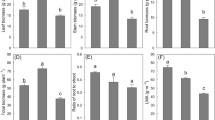Abstract
Photoinhibition and pigment composition of green stem tissues of field-grown adult Eucalyptus nitens were measured on clear spring days with low morning temperatures—conditions that cause photoinhibition in leaves of many plant species. The sun-exposed (north-facing) bark contained less chlorophyll a+b (531 vs 748 μmol m−2), neoxanthin (29 vs 41), and β-carotene (54 vs 73), more xanthophyll cycle pigments per unit surface area and per unit chlorophyll (71 vs 53 μmol m−2 and 141 vs 66 mmol mol−1 chlorophyll), and less lutein per unit chlorophyll (239 vs 190) than the shaded (southern) side. Maximum electron flow rates were 60 μmol m−2 s−1 on the sun-exposed side, and about 10 μmol m−2 s−1 on the shaded side. Fv/Fm was always lower than 0.8 on the sun-exposed side and the de-epoxidation state (DEPS) of the xanthophyll cycle was dominated by zeaxanthin in midday samples. Fv/Fm increased quickly after darkening, but DEPS recovered more slowly to 40% overnight. This suggested that rapidly reversible pH-dependent quenching was responsible for the bulk of changes in PS II efficiency. Fv/Fm remained below 0.8 overnight, which may well be indicative of photo-damage to PSII. In contrast, DEPS of the shaded side was lower, and Fv/Fm was higher, than for the sun-exposed side. We conclude that E. nitens chlorenchyma on the sun-exposed stem side has a photosynthetic pigment composition similar to sun leaves and it experiences significant photoinhibition in the field.





Similar content being viewed by others
References
Adams WW, Demmig-Adams B, Rosenstiel TN, Brightwell AK, Ebbert V (2002) Photosynthesis and photoprotection in overwintering plants. Plant Biol 4:545–557
Alves PL, Magalhaes A, Barja PR (2002) The phenomenon of photoinhibition of photosynthesis and its importance in reforestation. Bot Rev 68:193–208
Aschan G, Wittmann C, Pfanz H (2001) Age-dependent bark photosynthesis of aspen twigs. Trees 15:431–437
Bortz J, Lienert GA, Boenke K (1990) Verteilungsfreie Methoden in der Biostatistik. Springer, Berlin Heidelberg New York
Chattaway MM (1953) The anatomy of bark. I. The genus Eucalyptus. Aust J Bot 1:402–433
Close DC, Beadle CL, Hovenden MJ (2001) Cold-induced photoinhibition and foliar pigment dynamics of Eucalyptus nitens seedlings during establishment. Aust J Plant Physiol 28:1133–1141
Hovenden MJ, Warren CR (1998) Photochemistry, energy dissipation and cold-hardening in Eucalyptus nitens and E. pauciflora. Aust J Plant Physiol 25:581–589
Manetas Y (2004) Probing corticular photosynthesis through in vivo chlorophyll fluorescence measurements: evidence that high internal CO2 levels suppress electron flow and increase the risk of photoinhibition. Physiol Plant 120:509–517
Maxwell K, Johnson GN (2000) Chlorophyll fluorescence—a practical guide. J Exp Bot 51:659–668
Niinemets Ü, Bilger W, Kull O, Tenhunen JD (1998) Acclimation to high irradiance in temperate deciduous trees in the field: changes in xanthophyll cycle pool size and in photosynthetic capacity along a canopy light gradient. Plant Cell Environ 21:1205–1218
Niinemets Ü, Kollist H, Garcia-Plazaola JI, Hernandez A, Becerril JM (2003) Do the capacity and kinetics for modification of xanthophyll cycle pool size depend on growth irradiance in temperate trees? Plant Cell Environ 26:1787–1801
Niyogi KK, Shih C, Chow WS, Pgson BJ, DellaPenna D, Björkman O (2001) Photoprotection in a zeaxanthin- and lutein-deficient double mutant of Arabidopsis. Photosynth Res 67:139–145
Öquist G, Huner NPA (2003) Photosynthesis of overwintering evergreen plants. Annu Rev Plant Biol 54:329–355
Pfanz H, Aschan G, Langenfeld-Heyser R, Wittmann C, Loose M (2002) Ecology and ecophysiology of tree stems: corticular and wood photosynthesis. Naturwissenschaften 89:147–162
Sachs L (1992) Angewandte Statistik, 7. Auflage. Springer, Berlin Heidelberg New York
Tausz M, Wonisch A, Grill D, Morales D, Jiménez MS (2003) Measuring antioxidants in tree species in the natural environment. From sampling to data evaluation. J Exp Bot 54:1505–1510
Tausz M, Warren CR, Adams MA (2005) Dynamic light use and protection from excess light in upper canopy and coppice leaves of Nothofagus cunninghamii in an old growth, cool temperate rainforest in Victoria, Australia. New Phytol 165:143-156
Warren CR, Hovenden MJ, Davidson NJ, Beadle CL (1998) Cold hardening reduces photoinhibition of Eucalyptus nitens and E. pauciflora at frost temperatures. Oecologia 113:350–359
Wittmann C, Aschan G, Pfanz H (2001) Leaf and twig photosynthesis of young beech (Fagus sylvatica) and aspen (Populus tremula) trees grown under different light regime. Basic Appl Ecol 2:145–154
Acknowledgements
The Australian Research Council is warmly thanked for providing financial support
Author information
Authors and Affiliations
Corresponding author
Rights and permissions
About this article
Cite this article
Tausz, M., Warren, C.R. & Adams, M.A. Is the bark of shining gum (Eucalyptus nitens) a sun or a shade leaf?. Trees 19, 415–421 (2005). https://doi.org/10.1007/s00468-004-0400-5
Received:
Accepted:
Published:
Issue Date:
DOI: https://doi.org/10.1007/s00468-004-0400-5




